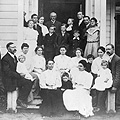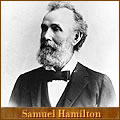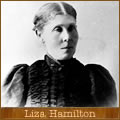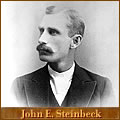The Hamiltons and Steinbecks in Fact and Fiction

Initially, Steinbeck's plan was to write this book for his boys, Thom and John, and to address the Hamilton chapters to them, "to tell them what their blood is." Curiously, he seems barely interested in the Steinbeck blood, his father's Germanic roots—he was more descriptive of his mother's Irish lineage. From her family came the stories, the creativity, the passion. Although dates are rearranged and personalities heightened, the Hamilton family stories are true. And in the story of the Trasks and Lee, Steinbeck suggests much about the emotional context of his own family.
Photo Credit: The Steinbeck House / Valley Guild

Steinbeck hardly knew his grandfather, Samuel Hamilton, who died in 1904, when Steinbeck was two. "He died when I was quite young," Steinbeck wrote, "but it is remarkable how much I remember about him." Samuel was a dreamer, an inventor, an idealist, a maker. From those qualities, which in fact did help insure Hamilton family poverty, Steinbeck creates a legend, an heroic figure whose language is likened to music, whose stature is etched against the sky, whose wisdom runs as deep as the wells he digs. He taps ancient streams. Samuel brings into the book, as was Steinbeck's intention, "a great deal of laughter," of fun, which for Steinbeck was an essential quality of human experience (Journal 9). The real story of Sam Hamilton is perhaps less romantic. When he came to America from Ireland in 1846, he lived briefly in New York and then arrived in California in about 1850, right after the gold rush. He and Liza first settled in San Jose, where the family lived for nearly twenty years. Most of the children were born there. In 1871, Sam moved the family to Salinas, then to King City in 1873, where he did, in fact, settle on the bone-dry acres described in East of Eden.
Why Does Steinbeck Deepen His Nature?
Steinbeck uses Sam Hamilton as a kind of creative center: He's what Tom Joad (a character in The Grapes of Wrath) was for the 1950s, the Cold War era: a hero whose ideas and values endure in characters' memories after he dies. If Tom Joad's legacy is social engagement, Samuel's is a plumb line for individual ethical action.
Emotional Context: Steinbeck's Family Trauma
Why does Samuel die in 1911 (in the book) and not 1904? Perhaps Steinbeck shifted dates so that the great decline of the Hamilton family—the deaths of Una, Samuel, Dessie and Tom —occur in quick succession during years when Steinbeck's own family suffered greatly. (Dessie died in 1907, Tom in 1912.) Samuel's agony after Una's death suggests the Steinbeck family's own suffering in 1911, when Mr. Steinbeck lost his job at Sperry Flour Mill. From the ages of nine to18, John Steinbeck felt acutely his own family's loss of security, as his father floundered, trying to find a stable financial footing. Certainly much of Aron's humiliation at Adam's business failure and Cal's restlessness is grounded in Steinbeck's own painful memories of his teenage years.
Source: Journal of a Novel: The East of Eden Letters by John Steinbeck (The Viking Press, Inc.,1969; Penguin Books, 1990)
Photo Credit: The Steinbeck House / Valley Guild
Why Does Steinbeck Deepen His Nature?
Steinbeck uses Sam Hamilton as a kind of creative center: He's what Tom Joad (a character in The Grapes of Wrath) was for the 1950s, the Cold War era: a hero whose ideas and values endure in characters' memories after he dies. If Tom Joad's legacy is social engagement, Samuel's is a plumb line for individual ethical action.
Emotional Context: Steinbeck's Family Trauma
Why does Samuel die in 1911 (in the book) and not 1904? Perhaps Steinbeck shifted dates so that the great decline of the Hamilton family—the deaths of Una, Samuel, Dessie and Tom —occur in quick succession during years when Steinbeck's own family suffered greatly. (Dessie died in 1907, Tom in 1912.) Samuel's agony after Una's death suggests the Steinbeck family's own suffering in 1911, when Mr. Steinbeck lost his job at Sperry Flour Mill. From the ages of nine to18, John Steinbeck felt acutely his own family's loss of security, as his father floundered, trying to find a stable financial footing. Certainly much of Aron's humiliation at Adam's business failure and Cal's restlessness is grounded in Steinbeck's own painful memories of his teenage years.
Source: Journal of a Novel: The East of Eden Letters by John Steinbeck (The Viking Press, Inc.,1969; Penguin Books, 1990)
Photo Credit: The Steinbeck House / Valley Guild

Liza was, Steinbeck wrote, "a little bog-trotting" woman who, "I am told, put out milk for the leprechauns in the hills behind King City, California, and when a groundling neighbor suggested the cats drank it, gave the neighbor a look that burned off his nose." Liza stayed on the ranch with Tom for four years after Samuel died; after Tom's suicide in 1912, she moved to Pacific Grove, where she lived the remainder of her life, dying in 1918 during a flu epidemic.
Photo Credit:The Steinbeck House / Valley Guild
Photo Credit:The Steinbeck House / Valley Guild

Steinbeck's mother was formidable, as the story of the airplane ride from the Salinas Californian suggests: "I can remember my mother sitting in our family box [at the California Rodeo] with bull dust gradually settling over her and refusing to leave until the last of the wild horses crossed the finish line...she always seemed to me a little bit like Queen Victoria sitting in that box...Queen Victoria slightly dusted over with Bull dust."
In 1905 she was a charter member of the first social club in Salinas, the Wanderers Club, which met three or four times a month to discuss travel books. There were 30 members from around the county, a select group clearly, and everyone did a report on one country each month. In 1905 when Mary Steinbeck was born on the same month that Olive was to give her report, she, undaunted, reported on schedule. Olive was active in town affairs and, to her family, often seemed almost too busy with a breathless social life.
Source: Salinas Californian, January 11, 1969. John Steinbeck's letter to Dorothy Vera.
Photo Credits: Stanford University Libraries Department of Special Collections & University Archives
The Steinbeck House / Valley Guild
In 1905 she was a charter member of the first social club in Salinas, the Wanderers Club, which met three or four times a month to discuss travel books. There were 30 members from around the county, a select group clearly, and everyone did a report on one country each month. In 1905 when Mary Steinbeck was born on the same month that Olive was to give her report, she, undaunted, reported on schedule. Olive was active in town affairs and, to her family, often seemed almost too busy with a breathless social life.
Source: Salinas Californian, January 11, 1969. John Steinbeck's letter to Dorothy Vera.
Photo Credits: Stanford University Libraries Department of Special Collections & University Archives
The Steinbeck House / Valley Guild

Steinbeck's father could be a moody man, much like Adam Trask. Many of Steinbeck's recorded comments about his father note his quietness, his sense of failure, his remoteness. After his financial reversals of 1912–1918, Mr. Steinbeck, much like Adam Trask, felt like an old man and was in his late 40s and early 50s. But like Adam, there was much to admire in Mr. Steinbeck. Steinbeck wrote of him in an article on Arthur Miller, written in 1957: "My father was a great man, as any lucky man's father must be. He taught me rules I do not think are abrogated by our nervous and hysterical times. These laws have not been annulled; these rules of attitudes. He taught me—glory to God, honor to my family, loyalty to my friends, respect for the law, love of country and instant and open revolt against tyranny, whether it come from the bully in the schoolyard, the foreign dictator, or the local demagogue."
Source: "The Trial of Arthur Miller," Esquire, June 1957.
Photo Credit: The Steinbeck House / Valley Guild
Source: "The Trial of Arthur Miller," Esquire, June 1957.
Photo Credit: The Steinbeck House / Valley Guild



